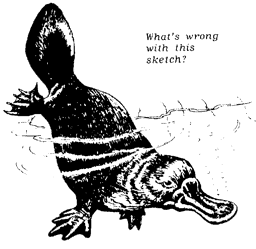 |
Science Frontiers ONLINE No. 75: May-Jun 1991 |
|
|
Platypus Paradoxes
After elucidating echidna eccentricities in the preceding item, we now provide platypus paradoxes.
- Did you know that the platypus bill is a finely tuned instrument with approximately 850,000 electrical and tactile receptors? These are far more sophisticated than those found in fish. When the platypus goes foraging underwater, a furry groove closes, covering its eyes and ears, and the nostrils on the bill are sealed shut. It becomes a high-tech predator -- despite all those snide remarks about its primitive nature.
- The poison spurs on the back legs of the male platypus are nothing to fool around with. They can cause humans severe pain and weeks of paralysis. And a dog can lose its life when a platypus clamps its legs around its muzzle and drives in its spurs. But, ask evolutionists, how did this poison apparatus get on the hind legs? The supposed ancestors of the platypus, the reptiles, modified their salivary glands for venom delivery. How did the platypusses break from this evolutionary mold and innovate?

It's not consistent with the text!
- The fossil record reveals that a platypus-like creature lived long before the Age of Mammals. These early platypusses had teeth in the adult phase, whereas their modern relatives replace their baby teeth with horny plates --
another innovation. Therefore, far from being a hodgepodge of parts left over from bird and reptile evolution, the platypus has actually pioneered several zoological features.
- Very curious is the fact that the platypus is in many ways like the beaver -- a very, very distant relative both in distance and position on the Tree of Life. Both platypus and beaver are furry, aquatic creatures with webbed feet and a large, flat tail. We have saved the strangest part for the end! Platypusses, being Monotremes (one-enders) have a common vent for waste and reproduction. Beavers, it turns out, are among the very rare placental mammals that (like the birds) possess a cloaca -- a common vent for urine and excrement.
(Hoffman, Eric; "Paradoxes of the Platypus," Scientific American, 264:18, March 1991.)
Comment. The "beaver" part just mentioned was not in Hoffman's article; we added it because it underscores the ap parent convergent evolution of platypus and beaver.
Reference. For many more platypus curiosities, refer to BMA25, BMA50 in our catalog Biological Anomalies: Mammals I and BMO8 in Biological Anomalies: Mammals II. Information on these books may be found here.